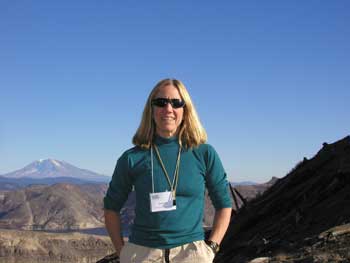Supervolcanoes are no match for Mary Reid, who is discovering ways to detect their eruptions possibly thousands of years before they erupt.
Reid, professor and chair of NAU’s Department of Geology, studies supervolcanoes, and is discovering ways to predict their power, known for wiping out societies with a single eruption.
The February volume of Elements Magazine, an international magazine of mineralogy, geochemistry and petrology, is devoted to supervolcanoes and includes a science paper by Reid, “How Long Does it Take to Supersize an Eruption?”
“We now can use various techniques, including radioactive decay and the chemical variations within minerals to estimate how long it takes for magma to collect below the earth’s surface before erupting as a supervolcano,” Reid explained. “This gives us insight in the physical characteristics of a supervolcano magma chamber and our chances of predicting it.”
While rare, occurring at intervals of 10,000 to 100,000 years, they have devastating global impact.
“My work focuses on the methods we can use to determine when, before being transported the surface, the crystals contained with an erupting magma formed,” she said. “I conclude from these time measurements some ideas about how long before the eruption in the magma chamber was forming.”
Reid also addresses whether society should be concerned about an imminent super eruption. She said with current testing techniques, scientists would know a supervolcano could erupt years before it would happen.
Reid puts the possible devastation into an understandable scale.
“If an eruption this size were confined to campus, we would end up buried under more than 100 miles of rock,” Reid said. “But we also are learning that because we tend to look for evidence of relatively liquid-rich magma body to analyze the likelihood of an eruption, we might be missing the fact that liquid may be hiding out in a large volume of crystals.”
Reid studied supervolcanoes at Yellowstone in Wyoming and at Long Valley, Calif., that erupted approximately a half a million years ago and the Toba volcano in Indonesia, which erupted 75,000 years ago and left few survivors.



